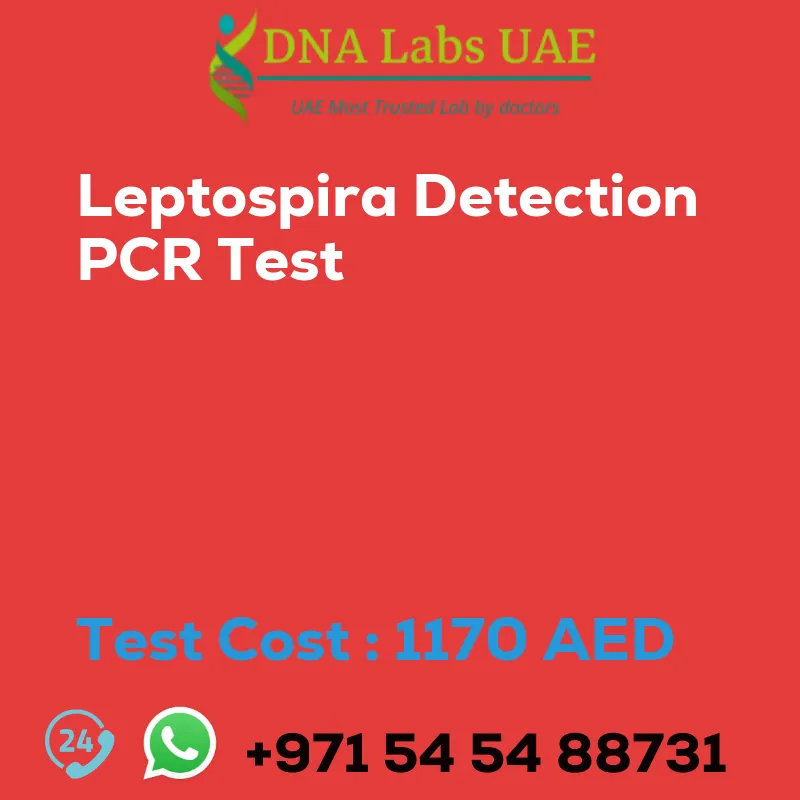LEPTOSPIRA DETECTION PCR Test
Components
- Price: 1170.0 AED
Sample Condition
4 mL (2 mL min.) whole blood in 1 Lavender top (EDTA) tube OR 10 mL urine in a sterile screw capped container. Ship refrigerated. DO NOT FREEZE.
Report Delivery
Sample: Wed / Sat by 11 am
Report: Mon / Thu
Method
PCR (Polymerase Chain Reaction)
Test Type
Infections
Doctor
Physician
Test Department
MOLECULAR DIAGNOSTICS
Pre Test Information
No special preparation required
Test Details
The LEPTOSPIRA DETECTION PCR test is a molecular diagnostic test used to detect the presence of Leptospira bacteria in a sample. Leptospira is a genus of bacteria that can cause a disease called leptospirosis, which can affect both humans and animals.
The PCR (polymerase chain reaction) test is a highly sensitive and specific method that amplifies and detects the genetic material (DNA or RNA) of the bacteria in the sample. It can detect even very small amounts of the bacteria, making it a valuable tool for early diagnosis and surveillance of leptospirosis.
To perform the LEPTOSPIRA DETECTION PCR test, a sample is collected from the patient, typically blood, urine, or cerebrospinal fluid. The genetic material in the sample is then extracted and purified. Specific primers, which are short DNA sequences that bind to the target DNA of Leptospira, are added to the sample.
The primers flank the target DNA region, and a DNA polymerase enzyme is used to amplify the target DNA through multiple cycles of heating and cooling. If the target DNA of Leptospira is present in the sample, the primers will bind to it and the DNA polymerase will amplify it, resulting in the production of many copies of the target DNA sequence.
The amplified DNA is then detected using various methods, such as gel electrophoresis or fluorescent probes, to determine the presence or absence of Leptospira in the sample.
The LEPTOSPIRA DETECTION PCR test is a rapid and accurate method for diagnosing leptospirosis, especially in the early stages of infection when other diagnostic methods may not be as reliable. It is also useful for monitoring the effectiveness of treatment and for epidemiological studies to identify the source and transmission of Leptospira bacteria.
Overall, the LEPTOSPIRA DETECTION PCR test is an important tool in the diagnosis and surveillance of leptospirosis, helping to guide appropriate treatment and control measures.
| Test Name | LEPTOSPIRA DETECTION PCR Test |
|---|---|
| Components | |
| Price | 1170.0 AED |
| Sample Condition | 4 mL (2 mL min.) whole blood in 1 Lavender top (EDTA) tube OR 10 mL urine in a sterile screw capped container. Ship refrigerated. DO NOT FREEZE. |
| Report Delivery | SampleWed / Sat by 11 am; Report Mon / Thu |
| Method | PCR |
| Test type | Infections |
| Doctor | Physician |
| Test Department: | MOLECULAR DIAGNOSTICS |
| Pre Test Information | No special preparation required |
| Test Details |
The LEPTOSPIRA DETECTION PCR test is a molecular diagnostic test used to detect the presence of Leptospira bacteria in a sample. Leptospira is a genus of bacteria that can cause a disease called leptospirosis, which can affect both humans and animals. The PCR (polymerase chain reaction) test is a highly sensitive and specific method that amplifies and detects the genetic material (DNA or RNA) of the bacteria in the sample. It can detect even very small amounts of the bacteria, making it a valuable tool for early diagnosis and surveillance of leptospirosis. To perform the LEPTOSPIRA DETECTION PCR test, a sample is collected from the patient, typically blood, urine, or cerebrospinal fluid. The genetic material in the sample is then extracted and purified. Specific primers, which are short DNA sequences that bind to the target DNA of Leptospira, are added to the sample. The primers flank the target DNA region, and a DNA polymerase enzyme is used to amplify the target DNA through multiple cycles of heating and cooling. If the target DNA of Leptospira is present in the sample, the primers will bind to it and the DNA polymerase will amplify it, resulting in the production of many copies of the target DNA sequence. The amplified DNA is then detected using various methods, such as gel electrophoresis or fluorescent probes, to determine the presence or absence of Leptospira in the sample. The LEPTOSPIRA DETECTION PCR test is a rapid and accurate method for diagnosing leptospirosis, especially in the early stages of infection when other diagnostic methods may not be as reliable. It is also useful for monitoring the effectiveness of treatment and for epidemiological studies to identify the source and transmission of Leptospira bacteria. Overall, the LEPTOSPIRA DETECTION PCR test is an important tool in the diagnosis and surveillance of leptospirosis, helping to guide appropriate treatment and control measures. |








